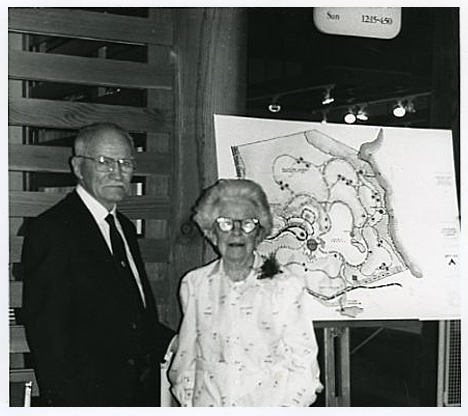Francis and Ann Marie Koenig
About Annmarie Sculpture Garden & Arts Center

"Everything I have built in my life will someday be taken down. Annmarie Garden will always remain." – Fran Koenig
Who is Annmarie?
Francis and Ann Marie Koenig first came to Calvert County in 1955 seeking a retreat from Fran’s career as an architect, builder, and developer in Washington, DC. They quickly fell in love with the area, and in 1956, they built a beach house in Long Beach. Soon after, they became avid sailors, often seen heading out from Flag Harbor Marina on their sailboat, "Annmarie." They shared their love for the area with their family, taking their grandchildren on walks through the American Chestnut Land Trust on Parker's Creek.
Investment and Land Donation
In 1960, as an investment, Francis and Annmarie Koenig purchased 30 acres of land in Solomons, Maryland. After thirty-two years, and despite numerous offers from developers, Fran realized that the land represented a unique opportunity to give something back to the community he loved.
In 1991, the Koenig family donated this property to Calvert County with the intention of developing it into a sculpture park. The park was named "Annmarie" after Fran's wife, Ann Marie Koenig. Over the next decade, six permanent works of art were installed, marking the beginning of Annmarie Sculpture Garden.
Although Francis and Ann both passed away in the 1990s, their dream lives on through Annmarie Garden. Today, the garden stands as a testament to their gratitude for the years they spent at their beach home on the Chesapeake Bay. Their generous gift offers a unique space in Calvert County where visitors can experience the fusion of art and nature.
Francis & Ann M. Koenig
Born in Chicago in 1910, Francis was the first of seven children. While his early years were spent in Chicago, he grew up on a farm in the Shenandoah Valley of Virginia. His interest in drafting began by designing and building chicken houses, leading him to build his first board and T-square. At the age of sixteen, he worked as a carpenter’s helper, which inspired him to pursue a career in architecture.
Due to the increasing demands of the farm, Francis completed only the seventh grade. He continued studying architecture through correspondence courses and, by the age of eighteen, was designing plans for houses, churches, store remodelings, and even “hunting boxes.” His ability to see his designs through to completion made him stand out, as he was intimately involved in the execution of his ideas. As he often stated, "I was blessed a thousand-fold through participation."
In 1935, Francis moved to Washington, DC, where he worked as a designer for Kennedy-Chamberlain and later as a drafter for Harvey Warwick, chief architect for Gustave Ring. By 1940, he had become vice president of Ring Engineering Company, designing and overseeing projects like Colonial Village (2nd phase) in Arlington, Virginia, and the Dorcester House in Washington, DC. After serving as a captain in the Army Corps of Engineers during World War II, Francis began designing and developing on his own, working on subdivisions, office buildings, churches, and his own home in Arlington, Virginia.
In 1955, Francis discovered a plot of land overlooking the Chesapeake Bay. The area, known as Long Beach, became the Koenig’s escape from city life. In 1956, he built the “beach house” at 234 Overlook Drive, where he and Ann enjoyed breathtaking views of the Bay. Despite extensive travel across Europe and the Caribbean, they both agreed that the view from their kitchen table was the best in the world.
In 1965, Francis and Ann purchased their first sailboat, which they named "Annmarie." They enjoyed sailing the Bay with their dachshund, Hansel, and often took overnight trips to Solomon’s Island and the Choptank and Little Choptank Rivers.
In 1960, as an investment, Francis purchased 30 acres of land in Solomons Island, overlooking St. John’s Creek. Over time, Francis saw the potential to create something lasting and unique—a sculpture garden instead of a condominium complex or hotel. In gratitude for the years spent on the Bay and in Calvert County, he donated the land to become Annmarie Sculpture Garden, ensuring that it would remain a permanent gift to the community.
As Fran often said, "Everything I have built in my life will someday be taken down. Annmarie Garden will always remain."






